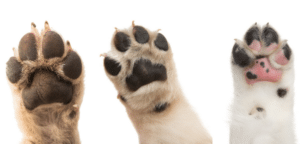
Dogs, unlike humans, walk barefoot everywhere they go. Pavement, sand, and sometimes dirt can become unbearably hot, which can take a toll on our companions’ paw pads. By taking a few simple precautions, you can ensure your dog enjoys a safe and happy adventure outside each day!
How to Tell if It’s Too Hot
When heading out for a walk with your pet, ensure the ground isn’t too hot for their paws. A simple way to check is to place the back of your hand on the ground and hold it there for about 10 seconds. If it’s too hot for your hand, it’s too hot for your dog’s paws. Similarly, the temperature of the ground below is often much hotter than the air.
The Risks of Walking Without Protection
Burned/Torn/Cracked Paw Pads Hot surfaces like rocks, pavement, and debris can cause serious injuries to your dog’s paws, leading to burns, tears, and cracks. These injuries can not only be painful but could have long-term effects. You can tell if your pet’s paws have been burned, torn, or cracked with a few simple signs:
- Excessive licking of the paws
- Limping or favoring one leg
- Blisters, redness, or inflammation on the paw pads
If you suspect your dog’s paws are burned, follow these steps to provide relief:
- Cool the Affected Paws: Gently cool the paws under slow-running water. Ensure the water is cool, not ice-cold, to avoid further damage.
- Protect the Paws: Bandage each affected paw. If you don’t have bandages, a clean sock can provide temporary protection until you can get proper care.
Air Temperature Vs. Pavement Temperature:
- 77 degrees F = 125 degrees F
- 86 degrees F = 135 degrees F
- 87 degrees F = 143 degrees F
Overheating Dogs primarily regulate their body temperature through their paw pads and panting. When the ground is too hot, their paw pads can’t effectively cool them down, leading to overheating. This can result in hyperthermia or heat strokes, which can lead to more serious conditions. Easy ways to cool your overheated dog include:
- Moving to a shaded or cooler area
- Applying cool, wet towels to their body
(Make sure to use cool water as opposed to ice cold. Rapid cooling can be just as dangerous to a pet’s health.) - Using a cooling vest
Options for Protection
To prevent paw injuries and overheating, consider these protective measures:
- Dog Shoes, Socks, or Booties: These can provide a barrier between your dog’s paws and hot surfaces.
- Paw Balms: Applying a balm can help keep moisture in the paw pads and prevent them from drying out and cracking quickly.
- Carriers for Smaller Pups: Consider using shoulder harnesses or carriers to keep them off the hot ground.
- Adjust Walking Times: Walk your dog early in the morning or late in the evening when temperatures are cooler.
- Pavement Conditioning: Walk your dog on the pavement during cooler weather to help toughen their paw pads. This can build resistance to heat.
Things We Do to Offer Protection:
- Shaded pavilions offer cooler areas for play and rest in our outdoor yards
- Sprinklers and hoses in each yard and on our walkway cool down the turf and pavement
- Freshly filled water buckets provide hydration and cooling
- Pool time in our saltwater pool or kiddy pools provides opportunities to cool down and have fun!
Taking these precautions can help ensure that your dog stays safe and comfortable during the hot summer months. Remember, if it’s too hot for you, it’s definitely too hot for them.

